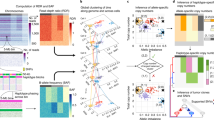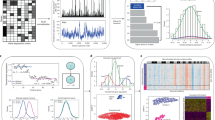Abstract
We present a protocol for reliably detecting DNA copy number aberrations in a single human cell. Multiple displacement-amplified DNAs of a cell are hybridized to a 3,000–bacterial artificial chromosome (BAC) array and to an Affymetrix 250,000 (250K)-SNP array. Subsequent copy number calling is based on the integration of BAC probe-specific copy number probabilities that are estimated by comparing probe intensities with a single-cell whole-genome amplification (WGA) reference model for diploid chromosomes, as well as SNP copy number and loss-of-heterozygosity states estimated by hidden Markov models (HMM). All methods for detecting DNA copy number aberrations in single human cells have difficulty in confidently discriminating WGA artifacts from true genetic variants. Furthermore, some methods lack thorough validation for segmental DNA imbalance detection. Our protocol minimizes false-positive variant calling and enables uniparental isodisomy detection in single cells. Additionally, it provides quality assessment, allowing the exclusion of uninterpretable single-cell WGA samples. The protocol takes 5–7 d.
This is a preview of subscription content, access via your institution
Access options
Subscribe to this journal
Receive 12 print issues and online access
$259.00 per year
only $21.58 per issue
Buy this article
- Purchase on Springer Link
- Instant access to full article PDF
Prices may be subject to local taxes which are calculated during checkout





Similar content being viewed by others
References
Vanneste, E. et al. Chromosome instability is common in human cleavage-stage embryos. Nat. Med. 15, 577–583 (2009).
Vanneste, E. et al. Genome-wide single cell array analysis for preimplantation genetic diagnosis of a complex chromosomal rearrangement carrier. Hum. Reprod. 18 (Suppl 1): 27 (2010).
Spits, C. et al. Whole-genome multiple displacement amplification from single cells. Nat. Protoc. 1, 1965–1970 (2006).
Treff, N.R., Su, J., Tao, X., Levy, B. & Scott, R.T. Accurate single cell 24 chromosome aneuploidy screening using whole genome amplification and single nucleotide polymorphism microarrays. Fertil. Steril. 94, 2017–2021 (2010).
Johnson, D.S. et al. Preclinical validation of a microarray method for full molecular karyotyping of blastomeres in a 24-h protocol. Hum. Reprod. 25, 1066–1075 (2010).
Alfarawati, S., Fragouli, E., Colls, P. & Wells, D. First births after preimplantation genetic diagnosis of structural chromosome abnormalities using comparative genomic hybridization and microarray analysis. Hum. Reprod. 26, 1560–1574 (2011).
Hu, D.G., Webb, G. & Hussey, N. Aneuploidy detection in single cells using DNA array-based comparative genomic hybridization. Mol. Hum. Reprod. 4, 283–289 (2004).
Le Caignec, C. et al. Single-cell chromosomal imbalances detection by array CGH. Nucleic Acids Res. 34, e68 (2006).
Hellani, A., Abu-Amero, K., Azouri, J. & El-Akoum, S. Successful pregnancies after application of array-comparative genomic hybridization in PGS-aneuploidy screening. Reprod. Biomed. Online 17, 841–847 (2008).
Fiegler, H. et al. High resolution array-cgh analysis of single cells. Nucleic Acids Res. 35, e15 (2007).
Geigl, J.B. et al. Identification of small gains and losses in single cells after whole genome amplification on tiling oligo arrays. Nucleic Acids Res. 37, e105 (2009).
Gutierrez-Mateo, C. et al. Validation of microarray comparative genomic hybridization for comprehensive chromosome analysis of embryos. Fertil. Steril. 95, 953–958 (2011).
Fiorentino, F. et al. PGD for reciprocal and Robertsonian translocations using array comparative genomic hybridization. Hum. Reprod. 26, 1925–1935 (2011).
Iwamoto, K. et al. Detection of chromosomal structural alterations in single cells by SNP arrays: a systematic survey of amplification bias and optimized workflow. PLoS ONE 2, e1306 (2007).
Treff, N.R., Su, J., Tao, X., Northrop, L.E. & Scott, R.T. Single cell whole genome amplification technique impacts the accuracy of SNP microarray based genotyping and copy number analysis. Mol. Hum. Reprod. 17, 335–343 (2011).
Handyside, A.H. et al. Karyomapping: a universal method for genome wide analysis of genetic disease based on mapping crossovers between parental haplotypes. J. Med. Gen. 47, 651–658 (2009).
Ampe, M., Verbeke, G., Vanneste, E. & Vermeesch, J.R. Analysis of array CGH data for the detection of single-cell chromosomal imbalances. Online J. Bioinformatics 11, 224–244 (2010).
Voet, T et al. Breakage-fusion-bridge cycles leading to inv dup del occur in human cleavage stage embryos. Hum. Mutat. 32, 783–793 (2011).
Di, X. et al. Dynamic model based algorithms for screening and genotyping over 100 K SNPs on oligonucleotide microarrays. Bioinformatics 21, 1958–1963 (2005).
Nannya, Y. et al. A robust algorithm for copy number detection using high-density oligonucleotide single nucleotide polymorphism genotyping arrays. Cancer Res. 65, 6071–6079 (2005).
Yurov, Y.B., Vorsanova, S.G. & Iourov, I.Y. GIN'n'CIN hypothesis of brain aging: deciphering the role of somatic genetic instabilities and neural aneuploidy during ontogeny. Mol. Cytogenet. 2, 23 (2009).
Stratton, M.R., Campbell, P.J. & Futreal, P.A. The cancer genome. Nature 458, 719–724 (2009).
Mkrtchyan, H. et al. Early embryonic chromosome instability results in stable mosaic pattern in human tissues. PLoS ONE 5, e9591 (2010).
Conlin, L.K. et al. Mechanisms of mosaicism, chimerism and uniparental disomy identified by single nucleotide polymorphism array analysis. Hum. Mol. Genet. 19, 1263–1275 (2010).
Coufal, N. et al. L1 retrotransposition in human neural progenitor cells. Nature 460, 1127–1131 (2009).
Piotrowski, A. et al. Somatic mosaicism for copy number variation in differentiated human tissues. Hum. Mutat. 29, 1118–1124 (2008).
Ballif, B.C. et al. Detecting sex chromosome anomalies and common triploidies in products of conception by array-based comparative genomic hybridization. Prenat. Diagn. 26, 333–339 (2006).
McLachlan, G. & Peel, D. Finite Mixture Models (Wiley-Interscience, 2000).
Böhning, D. Computer Assisted Analysis of Mixtures and Applications: Meta-Analysis, Disease Mapping, and Others (Chapman & Hall/CRC, 2000).
Durbin, R., Eddy, S., Krogh, A. & Mitchison, G. Biological Sequence Analysis (Cambridge University Press, 1998).
Acknowledgements
We are grateful to C. Melotte and P. Brady for the critical reading of the manuscript, to the Mapping Core and Map finishing groups of the Wellcome Trust Sanger Institute for initial BAC clone supply and verification, as well as to the microarray facility of the Flanders Interuniversity Institute for Biotechnology (VIB) for their help in spotting the arrays. This work was made possible by grants from the IWT (SBO-60848 to J.R.V. and Y.M.; TBM-090878 to J.R.V., T.V. and Y.M.); FWO-G.A093.11 to T.V. and J.R.V.; KUL PFV/10/016 SymBioSys to Y.M., J.R.V. and T.V.; GOA/12/015 to J.R.V.; and KUL GOA MaNet and EU FP7-Health CHeartED grants to Y.M. E.V. was supported by the Institute for the Promotion of Innovation through Science and Technology in Flanders (IWT-Vlaanderen).
Author information
Authors and Affiliations
Contributions
P.K., M.A., G.V., Y.M. designed the algorithms to analyze and combine BAC and SNP array results. E.V., T.V. and J.R.V. have developed the methods to analyze single cells using SNP-arrays. J.R.V., E.V., S.J. and T.V. developed the wet-lab protocols. E.V., T.V. and P.K. wrote the manuscript and all authors reviewed the manuscript. Y.M., J.R.V. and T.V. obtained the funding.
Corresponding authors
Ethics declarations
Competing interests
The authors declare no competing financial interests.
Supplementary information
Supplementary Data
Setup of Affymetrix reference data. (DOC 28 kb)
Rights and permissions
About this article
Cite this article
Konings, P., Vanneste, E., Jackmaert, S. et al. Microarray analysis of copy number variation in single cells. Nat Protoc 7, 281–310 (2012). https://doi.org/10.1038/nprot.2011.426
Published:
Issue Date:
DOI: https://doi.org/10.1038/nprot.2011.426
This article is cited by
-
An evolving view of copy number variants
Current Genetics (2019)
-
Single cell segmental aneuploidy detection is compromised by S phase
Molecular Cytogenetics (2014)
-
Copy-neutral loss of heterozygosity is prevalent and a late event in the pathogenesis of FLT3/ITD AML
Blood Cancer Journal (2014)
-
Preimplantation genetic diagnosis guided by single-cell genomics
Genome Medicine (2013)
-
Familial haplotyping and embryo analysis for Preimplantation Genetic Diagnosis (PGD) using DNA microarrays: a proof of principle study
Journal of Assisted Reproduction and Genetics (2013)
Comments
By submitting a comment you agree to abide by our Terms and Community Guidelines. If you find something abusive or that does not comply with our terms or guidelines please flag it as inappropriate.



